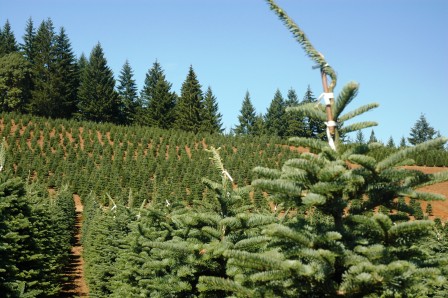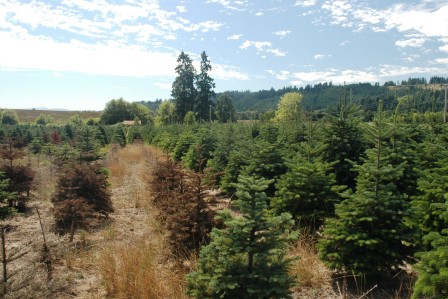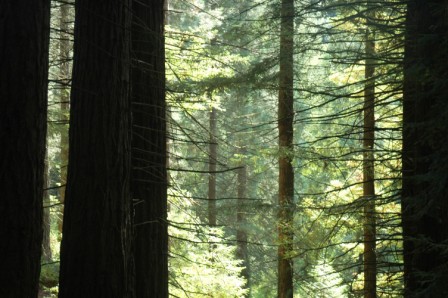A couple weeks back I posted about a collaborative research project that I am involved with to identify seed sources of two Mediterranean fir species (Turkish fir and Trojan fir) for use as Christmas trees in various locations around the country. The post prompted a question from Monta Zengerle who asked, “Must we continue to bring in exotics to satisfy the nursery trade?” Since our intended purpose is Christmas trees and people move plants around the world for purposes other than nursery stock, I’ve broadened the question to “Must we continue to bring in exotics?” for this discussion.

Not all exotic species introductions are man caused. This dock washed ashore in Oregon following the Japanese tsunami carrying all kinds of critters with it.
The answer, of course, is “No.” As human beings the only things we absolutely have to do are eat, sleep, and breathe. But the reality is much of the food and fiber production around the world, as well as our amenity plantings, are based on exotics plants. Human agricultural history is largely the story of plant importation and subsequent breeding. As Thomas Jefferson famously observed, “The greatest service which can be rendered any country is to add a useful plant to its culture.” However, it is doubtful that Jefferson considered kudzu or purple loosetrife could be among those plants added to our culture. Today we have a different understanding and realize that along with the economic benefits of plant exploration and importation comes the possibility of unintended and serious ecological consequences. And we’ve realized this for some time. People that deal with plant introductions on a regular basis talk about ecological errors and economic errors. If we allow importation of a plant that later turns out to be ‘bad actor’, we’ve made an ecologically harmful decision; if we ban a useful plant that ultimately would have turned out to be non-invasive, we’ve suffered an economic loss. Fortunately, only a small percentage of exotic species become naturalized and only small percentage of naturalized species become invasive. The underlying challenge is we cannot predict with 100% certainty which plants will be invasive in a new environment and which won’t. Ecologists are working on it and we can certainly begin to judge the invasive potential of new introductions. In the meantime, we are left with the imperfect calculation of whether the potential economic upside outweighs any potential environmental risk.

‘Top-work’ on noble fir in Oregon to maintain a single terminal leader. Turkish fir typically require less top-work.
So let’s look at our current project as a case study. What’s the upside? Christmas tree growers in the U.S. produce roughly 20 million trees annually. That’s a potential economic impact of hundreds of millions of dollars and seasonal and full-time employment for workers on over 13,000 farms from North Carolina to Washington State. A major issue for growers in virtually all of the principle growing regions is phytophthora root rot. Previous work at Oregon State University indicates that Turkish fir is highly resistant to this pathogen. By identifying seed sources with phytophthora resistance and superior Christmas tree characteristics (tree form, needle color, post-harvest needle retention), we will enable growers to continue or expand production and give consumers an additional choice for their holiday tree.

Native noble fir (left) is highly susceptible to root rot. Turkish fir (right) is much more resistant.
What’s the down side? As I mentioned, predicting invasiveness is difficult. That said, firs have several characteristics that make them unlikely invaders. Most firs have a relatively long juvenility period (age before they produce seed) which means they have a long period between generations. Secondly, most fir species produce seed crops sporadically as opposed to producing heavy seed crops year after year. Ecologically, firs are pretty wim
py; growing best on moisture, well-drained sites and unlikely to aggressively colonize disturbed areas. Lastly, the best predictor of invasiveness is invasiveness – a plant that has become invasive in one location is a candidate to become a repeat offender in a similar environment. Among conifers, the greatest issues with invasives have been pines (genus Pinus), in the southern hemisphere. In fact, all of the documented cases of invasives in the pine family (Pinaceae) are Pinus species; none were Abies. Based on all this, the likelihood of Turkish fir or Trojan fir becoming ecological problems appears very small, while the potential to add a useful plant to our culture is clear.

Exotic giant sequoias at Hoyt arboretum, Portland, OR.
Richardson, D.M. and Rejmánek. 2004. Conifers as invasive aliens: a global survey and predictive framework. Diversity and Distributions 10:321-331.